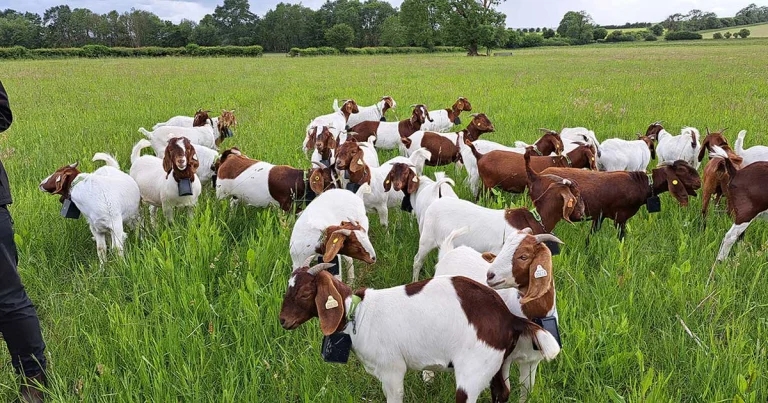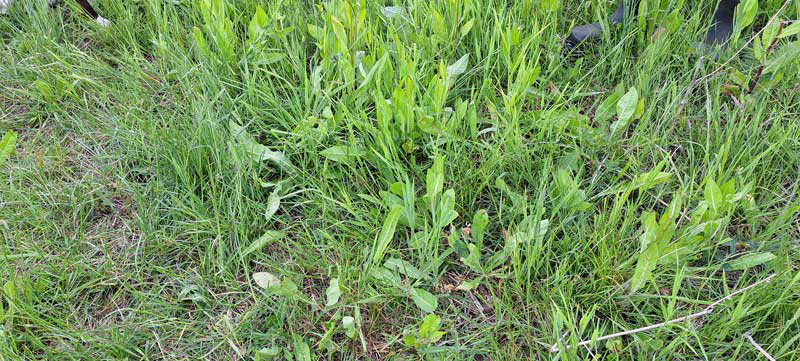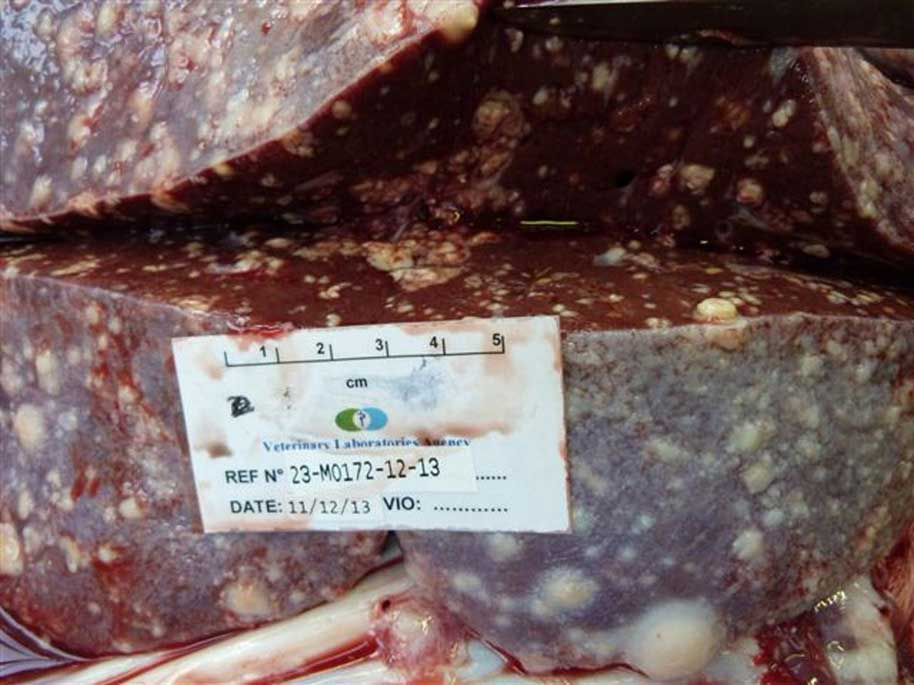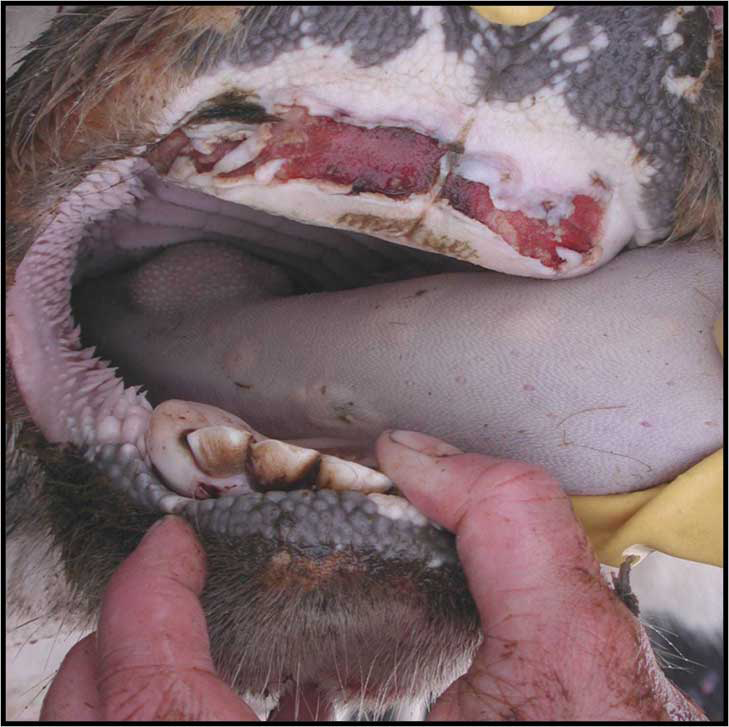16 Sept 2025
Round up of summer congress
David Harwood, BVetMed, FRCVS, recalls elements of the annual meeting of the Goat Veterinary Society.

Boer meat goats on a herbal ley.
The Goat Veterinary Society (GVS) Summer Congress was held 4-5 June in Swindon, where more than 60 delegates attended across the two days. Delegates met up on the first day at The Gourmet Goat Farmer, a large arable farm in Wiltshire, but with a pedigree herd of Boer goats reared very extensively for meat.
The farm has a strong sustainable objective and has wide swathes of grasslands, sweeping down from the ancient Ridgeway path to the historic village of Avebury, an UNESCO World Heritage Site. Much of it is designated as ancient pastures, which need management for the rare and native grassland species found here. This has presented the perfect opportunity to explore grazing regeneratively with goats.
Delegates were taken on a tour of the pasture by the owner, with all mature goats out grazing. A workshop was also run on farm by Cormac White of Future Farming Consultancy, a veterinary surgeon and farm advisor passionate about improving farm business profitability and sustainability.
A conference reception and dinner was held at the Village Hotel in Swindon, where a series of presentations took place on the second day.
Pastured dairy goat system
“Could a pasture-based dairy goat system ever work at scale in the UK?” was the title chosen by the first speaker Rachel Yarrow, a goat keeper and Nuffield scholar from Llangadog in Carmarthenshire.
The speaker is a well-known artisan cheese maker who described the “dream British cheese goat” as being one that has a steady reliable milk yield with high milk solids. Additionally, it should be hardy and able to cope with an outdoor existence, be parasite resistant and able to thrive on a grazed grass diet.
Goat cheese-making countries successfully using traditional extensive systems include Norway, France, Greece and Spain. Consumer choice should also not be ignored; one survey quoted three in five milk and cheese buyers would never buy milk produced in large indoor dairies. Any pasture-based system is not without its problems, however, including parasites, the need to make fencing “goat proof,” and the weather – goats traditionally do not like getting wet. The speaker’s study tour looked at systems in place in the Netherlands, France and Norway.
Underpinning any extensive system is the need to develop strong financial and marketing incentives. Any pasture should be a high protein one, with good management of goat movements via electric fence training and genetically to improve parasite resistance, morphology and coat.

Controlling the controllable
The second speaker of the day was Kate Bowen, veterinary director of UK Farmcare, who chose bovine TB as the topic of her talk, “bTB in goats; controlling the controllable!”, and an ongoing concern in goat keepers in high TB prevalence areas. Signs in goats include chronic weight loss, inappetence, and reduced milk yield with and also without respiratory signs, even though at postmortem the respiratory system is most often affected.
No routine testing of goats in the UK exists, with goats only being tested if suspicion arises of disease at PME or meat inspection, when the herd is co-located or adjacent to cattle breakdowns, or following epidemiological tracings.
Testing is undertaken using the single intradermal comparative cervical test (SICCT), as used in cattle, but with a suggestion to use each side of the neck due to their smaller size. A number of serological tests have been used with good success in goat herds, including Enferplex and Idexx, although these are not strictly validated for statutory use.
From September 2021 to date, 21,531 individual goats have been subjected to the SICCT in 650 herds (average of 33 goats per herd tested). Breakdowns can be explosive and have led to statutory depopulation.
Goat herd owners were then reminded of the benefits of taking advantage of visits from the TB Advisory Service; 29 goat herds have so far taken advantage of this over the past four years, and these visits are free. Visits are undertaken in conjunction with the farm’s vet practice and developing bespoke advice depending on individual farm circumstances. Further advice is available at tinyurl.com/urjs5yt4 and tinyurl.com/4w2jz87k

Notifiable disease update
Vanessa Swinson of the APHA and a GVS committee member then updated members on the current notifiable disease concerns across the UK and Europe. Starting with bluetongue (BTV), she confirmed that 261 cases of BTV-3 had now been confirmed between 26 August 2024 and 22 May 2025; in addition, one bovine animal was confirmed with BTV-12 in Kent. In the Netherlands, where the outbreak has been much more severe, mortality rates in affected goat herds was high particularly in goat kids, although the clinical impact is still greater in sheep.
The effect of vaccination has been assessed for cattle and sheep, but not yet for goats. Clinical disease in UK goats has been minimal, however. Moving on to foot-and-mouth disease (FMD), of concern has been reports of disease (serotype O) in water buffalo in Germany in January 2025 and then, in March 2025, FMD was confirmed in Hungary and Slovakia. This has led to increased vigilance in the UK and a ban on the import of a number of foodstuffs for personal consumption. Highly pathogenic avian influenza has been confirmed in around 1,000 dairy cattle herds in the US, and yet another one to be mindful of.

Veterinary medicines
Mike Stephens, head of the veterinary assessor team at the VMD, was invited to speak on the problems faced by the goat sector with limited products available.
The speaker reminded the audience of the work of the VMD, including inspections of medicines suppliers and distributors, pharmacovigilance and residues surveillance, enforcement of relevant legislation, and assuming UK policy lead on antimicrobial resistance.
Underpinning all this, however, is to promote the responsible use of veterinary medicines. The Product Information Database (PID) is a publicly available and searchable database of all UK authorised veterinary medicines.
The audience was reminded of the need to report any adverse events related to the use of any veterinary medicinal product, and this also includes any suspected lack of efficacy, and anyone can report, including not only vets but also concerned owners and keepers. Any such report should be made directly to the marketing authorisation holder; contact details are found on the product package leaflet. Companies then have a legal obligation to report onwards to VMD.
Second opinion cases
In her talk, “Second opinion goat cases; examples of what can be referred and how”, Andrea Turner of Langford Vets presented a number of cases that had been referred to her team from first opinion practices in her talk. As the team were co-located at the University of Bristol’s vet school, they were able to call in different disciplines to help, including small animal orthopaedic and soft tissue specialists. Her first case example was “Frank”, a three year old castrated male goat presenting with fracture of the proximal tibia. Fixation was not considered a viable option, and hindlimb amputation mid-femur was undertaken, with a very successful outcome. The cost of the procedure was discussed with the audience, who were told that an estimate will always be given before any work is undertaken.
Further referred case examples presented included a case of urolithiasis with a blockage in the penis of a male goat; correction of limb angular abnormalities in an 18-month-old sheep; and a femoral head fracture, again in a sheep. Any referral must begin with a good case discussion, in which possible diagnosis, subsequent treatment and potential cost can be discussed. Welfare must be high priority, including whether the patient can be transported humanely.
Silent troublemaker
Katherine Timms, ruminant veterinary advisor for Ceva Animal Health, then delivered her lecture, “Coxiella burnetii – a silent troublemaker”. The major route of contamination in both animals (goats, cattle and sheep) and humans is by inhalation of contaminated air particles originating from pregnant infected ruminant females. It is a very resistant organism, surviving in dust for four months, soil for five months and contaminated wool for up to nine months. It is a highly infectious agent; the only country worldwide that is Q fever-free is New Zealand.
On an infected ruminant farm where abortions and other reproductive problems are occurring related to Q fever, infection can be windborne to neighbouring farms. It is an important zoonotic disease; around 40% of those affected may show clinical signs of a “flu-like syndrome”, and up to 4% of these may have more severe disease and require hospitalisation.
Diagnosis can be problematic, as many infected animals may be asymptomatic yet still shedding bacteria, but both PCR and ELISA tests are available. The disease is “reportable” in England, Scotland and Wales, but is not “notifiable”, with no restrictions put in place, although the local health agency may be involved if zoonotic concerns are present. Control and prevention is based around breaking the cycle on farm and the use of the Ceva Coxevac vaccine.
Dispatch methods
“On farm dispatch methods of goats in the UK” was delivered by the final speaker in this session, Charlotte Butcher, a final-year undergraduate (awaiting her exam results) from the RVC. She presented some findings of her research project, which aimed to investigate how on-farm dispatch is being conducted and why, what other avenues for the sale of unwanted dairy male kids are being explored and how these impact on the mental health of those involved. In addition to the unwanted male kids, other reasons given were for sudden injury or illness, chronic welfare problems and other management reasons.
She was fortunate that goat owners and keepers responded from across the sector from very small to very large units. A full report of her findings will be published in the GVS Proceedings 2026.
Goat disbudding
The remainder of the conference was given over to discussion on the subject of goat disbudding. Ben Dustan, GVS president, began by giving a short presentation on his clinical approach to the procedure. This was then followed by an open discussion on the findings generated from the recent worldwide GVS survey.
The survey’s summary is available to members on the GVS website and will also be published in the society’s journal. In the discussion that followed, arguments were given from those stating that disbudding is a necessary procedure to protect both goats and those handling from the impact of horns, to others feeling that the procedure is unnecessary and should be stopped.
It was agreed, however, that it depended very much on how goats were kept and managed. This will be an ongoing issue, with GVS eventually developing a position on the subject.
- This article appeared in Vet Times (2025), Volume 55, Issue 37, Pages 15-16
- Dinner, dairy goat unit tour and discussion for delegates – more from Goat Veterinary Society
Author
David Harwood is a former Goat Veterinary Society president and is currently its programme secretary and journal editor.
